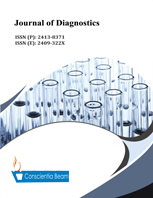The Potential Protective Role of Chamomile Extract on Rat Liver Ultrastructural Changes Induced by 2, 4-Dichlorophenoxyacetic Acid
DOI:
https://doi.org/10.18488/journal.98/2016.3.1/98.1.11.20Abstract
The current study aimed to demonstrate the hepatoprotective effect of chamomile extract and its role in relieving the ultrathin structure changes in liver tissue caused by 2, 4-Dichlorophenoxy acetic acid (2, 4-D) using electron microscopy.This experiment was performed on 12 -14 weeks old male Wistar rats divided into six groups (six animals each). The first group was kept as control. The second and third groups received orally accumulative doses of 75 and 150 mg/kg body weight (b.wt.), of 2, 4- D respectively. The forth group received orally Chamomile extract (500 mg/kg b.wt.) alone. The last two groups received Chamomile extract with either doses of 2, 4-D (75 or 150 mg/kg b.wt). At the end of the experimental period (4 weeks), the liver was dissected and examined by electron microscope. Histopathological examination of liver sections of rats administered 2, 4-D75 mg/kg showed differences in nuclear shapes and size, envelope and increase in heterochromatin masses. Adminstration of 2, 4-D150mg/kg showed pyknosis and changes inmitochondria, endoplasmic reticulum, Kupffer cells, increases in lysosomes and lipid droplets. Chamomile group showed the normal control ultra structure of the liver. In group treated with chamomile and 2, 4-D75,there was improvements in all degenerative changes induced by 2, 4-D75. Chamomile and 2, 4-D150 groupshowed partial improvement in both nucleus and the mitochondria. Chamomile reduces the oxidative damage induced by 2, 4-D due to its antioxidant properties. It is recommended that Chamomile extract can be taken to ameliorate hepatotoxicity.

